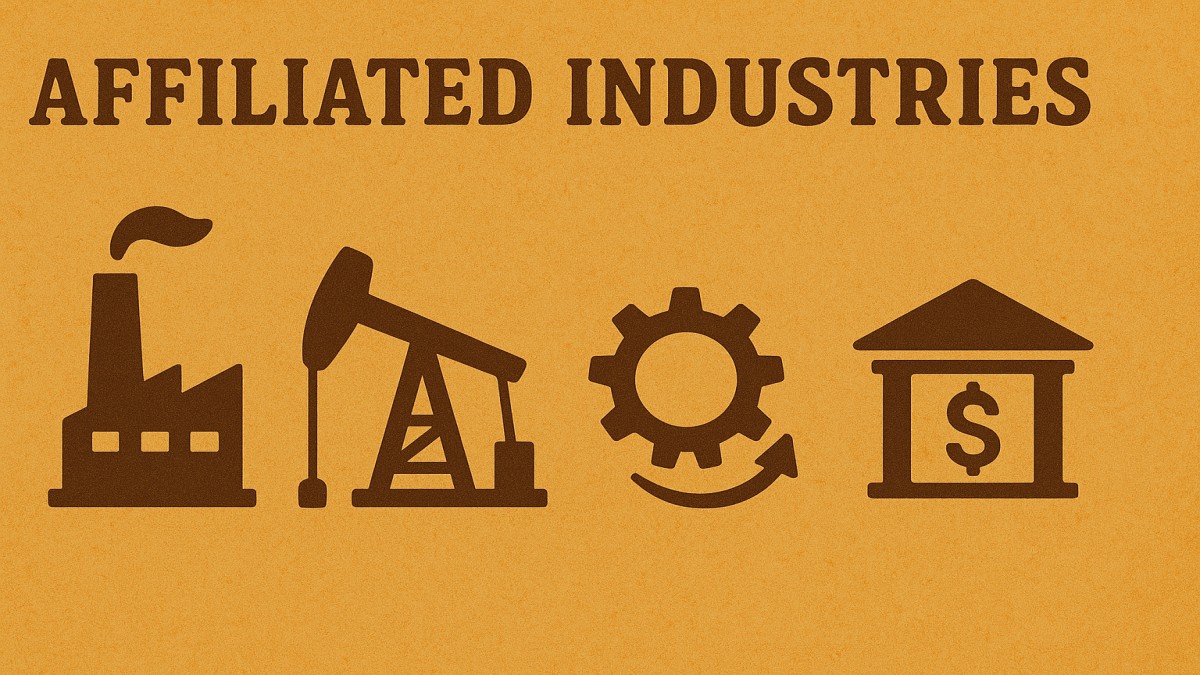Business
Affiliated Industries – Understanding the Interconnected Business Ecosystem
Published
2 months agoon
By
Gessolini
Introduction to Affiliated Industries
What Are Affiliated Industries?
Affiliated industries are sectors that are closely connected through supply chains, services, or shared markets. They may not produce the same goods or services, but they rely on each other for growth, innovation, and stability. For example, the automobile industry is affiliated with steel production, electronics manufacturing, and fuel supply.
Why Do Affiliated Industries Matter?
No business operates in isolation. Affiliated industries create mutual growth opportunities, help businesses share resources, and promote economic resilience by spreading risk across multiple markets.
The Interconnected Nature of Modern Industries
The Web of Economic Relationships
Think of industries as a spider web—if one thread (sector) shakes, the whole structure feels the impact. This is why shifts in one industry often create ripples in others.
Examples of Common Industry Affiliations
- Tourism ↔ Hospitality ↔ Transportation
- Agriculture ↔ Food Processing ↔ Packaging
- Healthcare ↔ Pharmaceuticals ↔ Medical Equipment
Types of Affiliated Industries
Direct Affiliation
Occurs when industries share a direct supply or demand relationship. Example: the fashion industry and textile manufacturing.
Indirect Affiliation
Happens when industries support each other through secondary services. Example: logistics companies serving e-commerce businesses.
Vertical Affiliation
Industries connected along a supply chain, such as raw material suppliers, manufacturers, and distributors.
Horizontal Affiliation
Industries in the same stage of production but offering different products, often sharing technologies or customer bases.
Key Examples Across Sectors
Technology and Telecommunications
Tech companies rely on telecommunications for connectivity, while telecom firms depend on tech advancements for better infrastructure.
Automotive and Energy
The electric vehicle market ties automotive manufacturing to renewable energy and battery technology.
Construction and Real Estate
Construction feeds real estate growth, and real estate demand fuels construction projects.
Entertainment and Advertising
The entertainment industry thrives with ad revenue, while advertising agencies rely on engaging media platforms.
Benefits of Affiliated Industries
Shared Growth Opportunities
When one sector expands, its affiliated industries often see increased demand.
Innovation and Knowledge Transfer
Cross-industry collaboration leads to faster innovation—like fintech combining finance and technology.
Economic Stability
Affiliations diversify revenue sources and reduce dependency on a single market.
Resource Optimization
Businesses can share distribution channels, labor pools, or R&D facilities.
Challenges in Managing Industry Affiliations
Market Dependency Risks
Over-reliance on one affiliated sector can cause major disruptions when that sector faces a downturn.
Regulatory Complexities
Different industries may have conflicting compliance requirements.
Competition vs Collaboration
Affiliates sometimes compete for resources or market share.
Supply Chain Vulnerabilities
A disruption in one industry can cascade through its affiliates.
Case Studies of Affiliated Industry Impact
Tourism and Aviation
When the aviation industry faces restrictions (e.g., during a pandemic), the tourism sector sees immediate losses.
Oil and Plastics
Oil price fluctuations impact plastic manufacturing costs, affecting packaging and consumer goods.
IT and Cybersecurity
As IT infrastructure grows, cybersecurity becomes an essential affiliated industry.
The Role of Globalization
International Trade Links
Global supply chains strengthen affiliations between industries across countries.
Offshoring and Outsourcing
Manufacturers in one country may rely heavily on affiliated service providers abroad.
Technology’s Influence on Affiliated Industries
Digital Transformation
Digital tools link industries more tightly than ever—shared platforms, cloud computing, and data analytics create real-time collaborations.
E-Commerce Ecosystem
Online retail affiliates include payment gateways, logistics providers, and marketing agencies.
Sustainability and Green Affiliations
Eco-Friendly Partnerships
Renewable energy industries are affiliating with construction, manufacturing, and transportation to reduce carbon footprints.
Circular Economy Models
Waste from one industry becomes raw material for another—like food waste powering bioenergy plants.
How Businesses Leverage Affiliated Industries
Strategic Alliances
Companies partner with affiliates for co-branding, shared R&D, or market expansion.
Joint Ventures
Two or more affiliated industries invest together in new projects.
Supply Chain Integration
Businesses integrate vertically or horizontally to strengthen affiliations.
Future Trends in Affiliated Industries
AI and Automation
AI will further link industries by optimizing processes across multiple sectors simultaneously.
Metaverse and Cross-Industry Collaboration
Virtual platforms will merge gaming, retail, and entertainment industries.
Global Resilience Planning
Post-pandemic strategies are emphasizing diversified affiliations to manage risks.
Conclusion
Affiliated industries form the backbone of our global economy. Their interconnectedness fuels innovation, stabilizes markets, and drives growth. As technology and globalization deepen these ties, understanding and managing industry affiliations will be critical for long-term success.
FAQs
1. What is an affiliated industry?
It’s a sector connected to another through supply chains, services, or shared markets.
2. Why are affiliated industries important?
They support mutual growth, share resources, and strengthen economic resilience.
3. Can a company belong to multiple affiliated industries?
Yes, many businesses operate across several affiliated sectors.
4. How does globalization affect affiliated industries?
It expands affiliations across borders, creating global interdependence.
5. What’s an example of an affiliated industry in daily life?
Coffee shops (hospitality) and dairy suppliers (agriculture) are common affiliates.

Small Gyro: The Compact Marvel of Motion and Balance

Types of Motorcycles: A Complete Guide for Every Rider

The Grapefruit Tree: Nature’s Citrus Powerhouse

Satellite: The Eyes of the Sky Transforming Our World

Hot Links: A Fiery Southern Favorite with a Flavorful History

Coca-Cola Boycott: A Deep Dive into the Global Movement

Poppy Seeds: Tiny Grains with Mighty Benefits

Inomyalgia: Understanding the Mysterious Muscle Pain Disorder

Kangaroo Meat: A Lean, Sustainable, and Nutrient-Rich Protein

Fenugreek (Foenegriek): The Ancient Spice with Modern Health Benefits

Wells Fargo Layoffs: What’s Happening and What It Means for the Future

Hanwha Eagles: A Legacy of Passion in Korean Baseball

Jyotish Veda: Unlocking the Cosmic Language of Vedic Astrology

Porkpie Hat: The Iconic Headwear with Timeless Appeal

The Complete Guide to Guichet Automatique Bancaire (GAB)

busy do szwajcarii szprotawa: A Complete Travel Guide

Colby Cheese: A Classic American Favorite

Time Revelstoke: A Mountain Town Where Time Slows Down

What is a Pedicure? A Complete Guide to Foot Pampering

Yaroa: The Dominican Comfort Food That’s Taking Over Plates and Hearts

Small Gyro: The Compact Marvel of Motion and Balance

Types of Motorcycles: A Complete Guide for Every Rider

The Grapefruit Tree: Nature’s Citrus Powerhouse

Satellite: The Eyes of the Sky Transforming Our World

Hot Links: A Fiery Southern Favorite with a Flavorful History

Coca-Cola Boycott: A Deep Dive into the Global Movement

Poppy Seeds: Tiny Grains with Mighty Benefits

Inomyalgia: Understanding the Mysterious Muscle Pain Disorder

Kangaroo Meat: A Lean, Sustainable, and Nutrient-Rich Protein

Fenugreek (Foenegriek): The Ancient Spice with Modern Health Benefits
Trending
-

 Blog2 months ago
Blog2 months agoBNY Mellon Layoffs: What’s Happening Behind the Scenes?
-

 education2 months ago
education2 months agoSnaggle Tooth: Causes, Impacts, and Solutions for a Misaligned Smile
-

 Blog2 weeks ago
Blog2 weeks agoWells Fargo Layoffs: What’s Happening and What It Means for the Future
-

 News2 months ago
News2 months agoKadaza Conservative News Sites – A Gateway to Right-Leaning Media Sources
